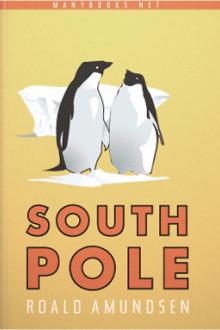A Book of Discovery by M. B. Synge (the snowy day read aloud txt) 📕

- Author: M. B. Synge
- Performer: -
Book online «A Book of Discovery by M. B. Synge (the snowy day read aloud txt) 📕». Author M. B. Synge
Important local discoveries were made by the young explorers, and their skill and courage earned for them a better equipment for further exploration. A whale-boat provisioned for six weeks, and a crew of six, were placed at the disposal of Bass in order that he might discover whether Van Diemen's Land was joined to the mainland or whether there was a strait between. Cook had declared that there was no strait. Flinders now tells the story of his friend's triumphant success in finding the straits that now bear his name. He tells how Bass found the coast turning westward exposed to the billows of a great ocean, of the low sandy shore, of the spacious harbour which "from its relative position to the hitherto known parts of the coasts was called Port Western." His provisions were now at an end and, though he was keen to make a survey of his new discovery, he was obliged to return. This voyage of six hundred miles in an open boat on dangerous and unknown shores is one of the most remarkable on record. It added another three hundred miles of known coast-line, and showed that the shores of New Holland were divided from Van Diemen's Land. So highly did the colonists appreciate this voyage of discovery that the whale-boat in which Bass sailed was long preserved as a curiosity.
A small boat of twenty-five tons, provisioned for twelve weeks, was now put at the disposal of the two friends, Flinders and Bass, to complete the survey of Van Diemen's Land, and in October 1798 they sailed for the south. With gales and strong winds blowing across the channel now known as Bass Strait, they made their way along the coast—the northern shores of Van Diemen's Land—till they found a wide inlet. Here they found a quantity of black swans, which they ate with joy, and also kangaroos, mussels, and oysters. This inlet they called Port Dalrymple, after the late hydrographer to the Admiralty in England. On 9th December, still coasting onward, they passed Three-Hummock Island and then a whole cluster of islands, to which, "in honour of His Excellency the Governor of New South Wales, I gave the title of Hunter's Isles." And now a long swell was noticed from the south-west. "It broke heavily upon a small reef and upon all the western shores, but, although it was likely to prove troublesome and perhaps dangerous, Mr. Bass and myself hailed it with joy and mutual congratulation, as announcing the completion of our long-wished-for discovery of a passage into the southern Indian Ocean."
Calling the point where the island coast turned Cape Grime, they sailed along the western shores, their little boat exposed to the swell of the southern ocean. Sailing joyfully from point to point and naming them at will, the two explorers reached the extreme west, which they called South-West Cape. This had been already sighted by one of Cook's party in 1773. South Cape and Tasman's Head had been likewise charted as points at the extreme south of New South Wales. So the explorers sailed right round the island on which Tasman had landed one hundred and fifty-six years before, and after an absence of five months they reached Sydney with their important news. Bass now disappears from the annals of exploration, but his friend Flinders went off to England and found in our old friend Banks a powerful friend. He was given a stout north-country ship, H.M.S. Investigator of three hundred and thirty-four tons, with orders to return to New Holland and make a complete survey of the coast, and was off again in July 1801 with young John Franklin, his nephew, aboard.
The Investigator arrived at Cape Leuwin in December and anchored in King George's Sound, discovered by Vancouver some ten years before. By the New Year he was ready to begin his great voyage round the Terra Australis, as the new country was still called. Indeed, it was Flinders who suggested the name of Australia for the tract of land hitherto called New Holland. His voyage can easily be traced on our maps to-day. Voyaging westward through the Recherches group of islands, Flinders passed the low, sandy shore to a cape he named Cape Pasley, after his late Admiral; high, bleak cliffs now rose to the height or some five hundred feet for a distance of four hundred and fifty miles—the great Australian Bight. Young Franklin's name was given to one island, Investigator to another, Cape Catastrophe commemorated a melancholy accident and the drowning of several of the crew. Kangaroo Island speaks for itself. Here they killed thirty-one dark-brown kangaroos. "The whole ship's company was employed this afternoon skinning and cleaning the kangaroos, and a delightful regale they afforded after four months' privation from almost any fresh provisions. Half a hundredweight of heads, forequarters, and tails were stewed down into soup for dinner, and as much steaks given to both officers and men as they could consume by day and night."
CAPE CATASTROPHE CAPE CATASTROPHE.From Flinders' Voyages.
In April 1802 a strange encounter took place, when suddenly there appeared a "heavy-looking ship without any top-gallant masts up," showing a French ensign. Flinders cleared his decks for action in case of attack, but the strangers turned out to be the French ship Le Géographe, which, in company with Le Naturaliste, had left France, 1800, for exploration of the Australian coasts.
Now it was well known that Napoleon had cast longing eyes upon the Terra Australis—indeed, it is said that he took with him to Egypt a copy of Cook's Voyages. Flinders, too, knew of this French expedition, but he was not specially pleased to find French explorers engaged on the same work as himself. The commanders met as friends, and Baudin, the French explorer, told how he had landed also near Cape Leuwin in May 1801, how he had given the names of his two ships to Cape Naturaliste and Géographe Bay, and was now making his way round the coast. Flinders little guessed at this time that the French were going to claim the south of New South Wales as French territory under the name of Terra Napoleon, though it was common knowledge that this discovery was made by Englishmen.
"Ah, captain," said one of the French crew to Flinders, "if we had not been kept so long picking up shells and catching butterflies at Van Diemen's Land you would not have discovered this coast before us."
When Baudin put in at Port Jackson a couple of months later, he inquired of the Governor the extent of British claims in the Pacific.
"The whole of Tasmania and Australia are British territory," was the firm answer.
After this encounter Flinders discovered and named Port Phillip, at the head of which stands the famous city of Melbourne to-day, and then made his way on to Port Jackson. He had managed his crews so well that the inhabitants of Port Jackson declared they were reminded of England by the fresh colour of the men amongst the Investigator ship's company. The Frenchmen had not fared so well. One hundred and fifty out of one hundred and seventy were down with scurvy and had to be taken to the hospital at Sydney.
Before the end of July, Flinders was off again, sailing northwards along the eastern coast of New South Wales. October found him passing the Great Barrier reefs, and on the 21st he had reached the northernmost point, Cape York. Three days of anxious steering took the Investigator through Torres Strait, and Flinders was soon sailing into the great Gulf of Carpentaria. Still hugging the coast, he discovered a group of islands to the south of the gulf, which he named the Wellesley Islands, after General Wellesley, afterwards Duke of Wellington. Here he found a wealth of vegetation; cabbage palm was abundant, nutmegs plentiful, and a sort of sandal-wood was growing freely. He spent one hundred and five days exploring the gulf; then he continued his voyage round the west coast and back to Port Jackson by the south. He returned after a year's absence with a sickly crew and a rotten ship. Indeed, the Investigator was incapable of further service, and Flinders decided to go back to England for another ship. As passenger on board the Porpoise, early in August 1802, he sailed from Sydney for the Torres Strait accompanied by two returning transports. All went well for the first four days, and they had reached a spot on the coast of Queensland, when a cry of "Breakers ahead!" fell on the evening air. In another moment the ship was carried amongst the breakers and struck upon a coral reef. So sudden was the disaster that there was no time to warn the other ships closely following. As the Porpoise rolled over on her beam ends, huge seas swept over her and the white foam leapt high. Then the mast snapped, water rushed in, and soon the Porpoise was a hopeless wreck. A few minutes later, one of the transports struck the coral reef: she fell on her side, her deck facing the sweeping rollers, and was completely wrecked. The other transport escaped, sailed right away from the scene of disaster, and was never seen again by the crew of the Porpoise. The dawn of day showed the shipwrecked crew a sandbank, to which some ninety-four men made their way and soon set sailcloth tents on the barren shore. They had saved enough food for three months. Flinders as usual was the moving spirit. A fortnight later in one of the ship's boats, with twelve rowers and food for three weeks, he left Wreck Reef amid ringing cheers to get help from Sydney for the eighty men left on the sandbank.
"The reader," says the hero of this adventure, "has perhaps never gone two hundred and fifty leagues at sea in an open boat or along a strange coast inhabited by savages; but, if he recollect the eighty officers and men upon Wreck Reef, and how important was our arrival to their safety and to the saving of the charts, journals, and papers of the Investigator's voyage, he may have some idea of the pleasure we felt, particularly myself, at entering our destined port."
Half-starved, unshaven, deplorable indeed were the men when they staggered into Sydney, and "an involuntary tear started from the eye of friendship and compassion" when the Governor learnt how nearly Flinders and his friends had lost their lives.
THE HUTS OF THE CREW OF THE PORPOISE ON THE SANDBANK, WRECK REEF THE HUTS OF THE CREW OF THE PORPOISE ON THE SANDBANK, WRECK REEF.From Flinders' Voyages.
A few days later Flinders left Sydney for the last time, in a little home-built ship of twenty-nine tons, the Cumberland. It was the first ship ever built in the colony, and the colonists were glad it should be of use to the man who had done so much for their country. With all his papers and his beloved journals, Flinders put to sea accompanied by a ship to rescue the men left on Wreck





Comments (0)